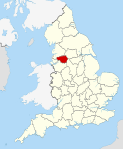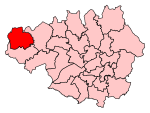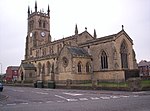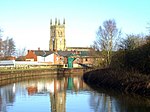Trencherfield Mill
Grade II listed buildings in the Metropolitan Borough of WiganHarv and Sfn no-target errorsMuseums in Greater ManchesterPreserved stationary steam enginesSteam museums in England ... and 3 more
Textile mills in the Metropolitan Borough of WiganTextile mills owned by the Lancashire Cotton CorporationUse British English from September 2017
Trencherfield Mill is a cotton spinning mill standing next to the Leeds and Liverpool Canal in Wigan, Greater Manchester, England. It was built in 1907. It was taken over by the Lancashire Cotton Corporation in the 1930s and passed to Courtaulds in 1964. The mill was driven by a 2,500 hp triple-expansion four-cylinder engine built by J & E Wood of Bolton in 1907. The two halves of the engine were called Rina and Helen. They drove a 26-foot flywheel with 54 ropes at 68 rpm. The engine was stopped in 1968. The mill is now part of the Wigan Pier redevelopment area and is used for other purposes.
Excerpt from the Wikipedia article Trencherfield Mill (License: CC BY-SA 3.0, Authors).Trencherfield Mill
Heritage Way,
Geographical coordinates (GPS) Address Website External links Nearby Places Show on map
Geographical coordinates (GPS)
| Latitude | Longitude |
|---|---|
| N 53.5411 ° | E -2.6378 ° |
Address
Trencherfield Mill
Heritage Way
WN3 4DU , Wallgate
England, United Kingdom
Open on Google Maps









